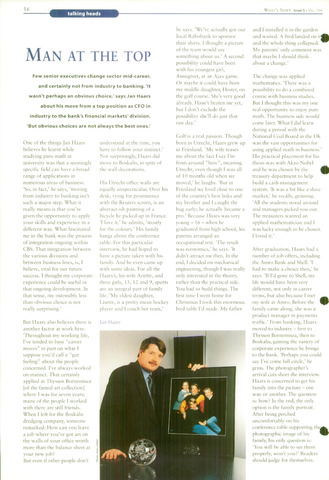Man at the top
16
talking heads
What's NewS Issue 5 May 1996
Few senior executives change sector mid-career,
and certainly not from industry to banking. 'It
wasn't perhaps an obvious choice,' says Jan Haars
about his move from a top position as CFO in
industry to the bank's financial markets' division.
'But obvious choices are not always the best ones.'
One of the things Jan Haars
believes he learnt while
studying pure math at
university was that a seemingly
specific field can have a broad
range of applications in
numerous areas of business.
'So, in fact,' he says, 'moving
from industry to banking isn't
such a major step. What it
really means is that you're
given the opportunity to apply
your skills and experience in a
different way. What fascinated
me in the bank was the process
of integration ongoing within
CBS. That integration between
the various divisions and
between business lines, is, I
believe, vital for our future
success. I thought my corporate
experience could be useful in
that ongoing development. In
that sense, my ostensibly less
than obvious choice is not
really surprising.'
But Haars also believes there is
another factor at work here.
'Throughout my working life,
I've tended to base "career
moves" in part on what I
suppose you'd call a "gut
feeling" about the people
concerned. I've always worked
on instinct. That certainly
applied at Thyssen Bornemisza
[of the famed art collection]
where I was for seven years;
many of the people I worked
with there are still friends.
When I left for the Boskalis
dredging company, someone
remarked: How can you leave
a job where you've got art on
the walls of your office worth
more than the balance sheet at
your new job?
But even if other people don't
understand at the time, you
have to follow your instinct.'
Not surprisingly, Haars did
move to Boskalis, in spite of
the wall decorations.
His Utrecht office walls are
equally unspectacular. Over his
desk, vying for prominence
with the Reuters screen, is an
abstract-ish painting of a
bicycle he picked up in France.
'I love it,' he admits, 'mostly
for the colours.' His family
hangs above the conference
table. For this particular
interview, he had hoped to
have a picture taken with his
family. And he even came up
with some ideas. For all the
Haars's, his wife Ariëtte, and
three girls, 15, 12 and 9, sports
are an integral part of family
life. 'My eldest daughter,
Lisette, is a pretty mean hockey
player and I coach her team,'
Jan Haars
he says. 'We've actually got our
local Rabobank to sponsor
their shirts. I thought a picture
of the team would say
something about us.' A second
possibility could have been
with his youngest girl,
Annegreet, at an Ajax game.
Or maybe it could have been
my middle daughter, Hester, on
the golf course. She's very good
already. Hasn't beaten me yet,
but I don't exclude the
possibility she'11 do just that
one day.'
Golf is a real passion. Though
born in Utrecht, Haars grew up
in Friesland. 'My wife teases
me about the fact I say I'm
from around "here", meaning
Utrecht, even though I was all
of 10 months old when we
moved,' he laughs. 'But in
Friesland we lived close to one
of the country's best links and
my brother and I caught the
bug early; he actually became a
pro.' Because Haars was very
young - 16 - when he
graduated from high school, his
parents arranged an
occupational test. 'The result
was economics,' he says. 'It
didn't attract me then. In the
end, I decided on mechanical
engineering, though I was really
only interested in the theory,
rather than the practical side.
You had to build things. The
first time 1 went home for
Christmas I took this enormous
bird-table I'd made. My father
and I installed it in the garden
and waited. A bird landed on i'^B
and the whole thing collapsed.
My parents' only comment was
that maybe I should think
about a change.'
The change was applied
mathematics. 'There was a
possibility to do a combined
course with business studies.
But I thought this was my one
real opportunity to enjoy pure
math. The business side would
come later. What 1 did learn
during a period with the
National Coal Board in the UK
was the vast opportunities for
using applied math in business.'
His practical placement for his
thesis was with Akzo Nobel
and he was chosen by the
treasury department to help
build a cash management
system. 'It was a bit like a slave
market,' he recalls, grinning.
'All the students stood around
and managers picked you out.
The treasurers wanted an
applied mathematician and 1
was lucky enough to be chosen.
I loved it.'
After graduation, Haars had a
number of job offers, including
the Amro Bank and Shell. 'I
had to make a choice then,' he
says. 'If I'd gone to Shell, my
life would have been very
different, not only in career
terms, but also because I met
my wife at Amro. Before the
family came along, she was a
product manager in payments
traffic.' From banking, Haars
moved to industry - first to
Thyssen Bornemisza, then to
Boskalis, gaining the variety of
corporate experience he brings
to the bank. 'Perhaps you could
say I've come full circle,' he
grins. The photographer's
arrival cuts short the interview.
Haars is concerned to get his
family into the picture - one
way or another. The question
is: how? In the end, the only
option is the family portrait.
After being perched
uncomfortably on his
conference table supporting tht^^
photographic image of his
family, his only question is:
'You will be able to see them
properly, won't you?' Readers
should judge for themselves.

